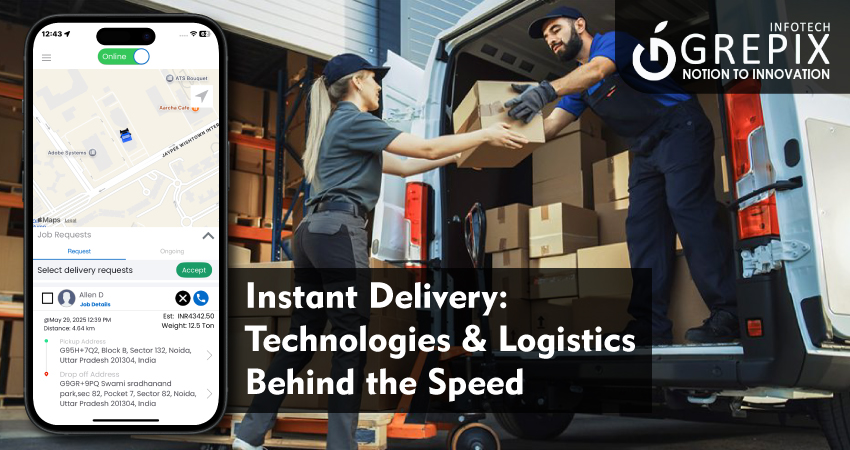Instant Delivery: Technologies & Logistics Behind the Speed
The New Era of On-Demand Apps
The on-demand revolution started with simple ideas—tap a button, get a ride or order food. Fast-forward to 2025, and the landscape is unrecognizable. On-demand apps are now ecosystems of convenience—covering mobility, shopping, healthcare, logistics, and even finance.
At the center of this shift lies taxi app development. From Uber clone solutions to fully customized ride-hailing apps, businesses worldwide are innovating to keep up with rising consumer demands. Today’s users expect instant access, personalized services, transparency, and sustainability.
Let’s explore the top on-demand app trends in 2025 and break down what users expect when they open their favorite apps.
The age of instant gratification has fundamentally reshaped e-commerce and logistics. This blog dives deep into how the promise of Instant Delivery is being fulfilled, revealing the complex, yet highly optimized, ecosystem of technology and logistics that operates behind the scenes. We explore the critical role of software, specifically the development of a sophisticated logistics app, which acts as the central nervous system for rapid fulfillment. From AI-driven route optimization and real-time tracking to the creation of micro-fulfillment centers, the entire supply chain is now digitized and streamlined for speed. For businesses aiming to compete, leveraging a specialized logistics app development company to build an advanced Fleet management app is no longer optional—it's essential for mastering the last-mile delivery challenge and meeting overwhelming customer demand for speed.
Instant Delivery: Technologies & Logistics Behind the Speed
In an era defined by instant gratification, the speed of delivery has become the single most critical differentiator for businesses globally. Customers now expect their orders to arrive not just quickly, but instantly. This shift has moved Instant Delivery from a futuristic concept to a practical necessity, creating a multi-billion dollar segment that is rapidly transforming retail, food service, and healthcare.
But what truly powers this extraordinary speed? It is not just fast vehicles, but a revolutionary integration of smart technology and optimized logistics. This article breaks down the core components, showcasing how custom logistics app development is the engine driving the modern, lightning-fast supply chain. We’ll explore the key technologies and logistical strategies that allow businesses to consistently deliver on the promise of speed, ensuring you understand what it takes to dominate the on demand logistics app development space.
The Digital Backbone: Logistics App Development and Software
At the heart of the Instant Delivery revolution is high-performance software. The ability to coordinate thousands of moving parts—inventory, drivers, traffic, and customers in real-time is only possible through sophisticated digital platforms. This is where a focused logistics app development company becomes indispensable.
The Role of the On Demand Logistics App Development
An on demand logistics app development project creates the central nervous system for an instant delivery operation. These applications are multi-faceted platforms that cater to customers, drivers, and dispatch managers, ensuring seamless communication and coordination across the entire delivery chain. Without this centralized digital platform, managing the demands of instant service would be logistically impossible.
The primary function is to transform a customer order into an immediate, actionable task for the closest available driver. This requires complex algorithms running in the background, constantly processing data points to maintain maximum efficiency. The architecture must be robust and scalable to handle sudden spikes in demand, a common challenge in the Instant Delivery sector.
Core Technology Features for Instant Delivery
To achieve true speed and reliability, an Instant Delivery solution must integrate several non-negotiable technological features. These components work together to shave minutes, and even seconds, off the total delivery time. Businesses must prioritize these features during the logistics app development phase.
AI-Powered Route Optimization and Planning
Route optimization is the single most important factor in reducing delivery time. Modern logistics platforms use Artificial Intelligence (AI) to analyze thousands of variables real-time traffic updates, weather conditions, road closures, driver locations, and delivery window constraints—in milliseconds.
The AI doesn't just find the shortest path; it finds the fastest and most economical route for a driver handling multiple drop-offs. This capability minimizes miles driven, cuts down on fuel costs, and directly contributes to faster, more reliable Instant Delivery service.
Real-Time GPS Tracking and Telematics
Real-time tracking is a critical feature that benefits both the business and the customer. For the customer, it provides peace of mind and transparency, showing exactly where their order is and when it will arrive. This transparency enhances the overall customer experience significantly.
For the business, telematics data collected via the logistics app provides continuous feedback on driver performance, idle time, and route adherence. This data is fed back into the optimization algorithms, creating a constant loop of improvement in the last-mile delivery process.
Automated Dispatch and Allocation System
Manual dispatching cannot cope with the sheer volume and speed required for Instant Delivery. Automated dispatch systems instantly match an incoming order to the most suitable driver based on proximity, vehicle capacity, and current workload. This process eliminates human latency entirely.
A sophisticated system, developed by an expert logistics app developer, can automatically re-route assignments if a driver faces an unexpected delay. This dynamic management ensures that the overall delivery network remains fluid and responsive under pressure, a hallmark of effective on demand logistics app development.
Mastering the Last Mile: Infrastructure and Fleet Management App
Technology alone is not enough; it must be supported by a smart physical infrastructure and an efficiently managed delivery fleet. The last mile—the final leg of the delivery journey from the hub to the customer's door—is the most expensive and time-consuming part of the process.
The Strategic Importance of Micro-Fulfillment Centers (MFCs)
To shrink the last mile, companies are shifting away from distant, large warehouses toward smaller Micro-Fulfillment Centers (MFCs). These centers are strategically placed in urban and densely populated areas, often operating with a high degree of automation.
By positioning inventory closer to the customer, the physical distance a driver must travel is drastically reduced. MFCs enable delivery companies to consistently meet ambitious Instant Delivery timeframes, making them a cornerstone of modern supply chain planning. This infrastructure fundamentally supports the speed promised by the logistics app.
The Efficiency Driver: Fleet Management App Solutions
A delivery fleet is a major operational asset and cost center. To maximize its efficiency, businesses rely on a dedicated Fleet management app. This software is vital for overseeing the entire lifecycle of a fleet, from vehicle health to driver behavior, directly impacting the ability to execute Instant Delivery reliably.
Vehicle Health and Predictive Maintenance
Downtime is the enemy of Instant Delivery. A modern Fleet management app tracks vehicle diagnostics in real-time, monitoring engine performance, tire pressure, and fluid levels. It uses this data to schedule predictive maintenance, ensuring vehicles are serviced before a breakdown occurs.
This proactive approach ensures that the fleet is always operational, minimizing costly and delivery-disrupting unexpected repairs. The app helps fleet managers maintain a high service uptime, which is crucial for a smooth on demand logistics app development solution.
Driver Performance and Behavior Monitoring
The driver is the human element in the last mile, and their performance is key. The Fleet management app provides insights into driving behavior, tracking metrics like harsh braking, excessive speeding, and idling time. This allows managers to coach drivers for safer, more fuel-efficient, and faster service.
Improved driving behavior not only enhances safety and reduces operational costs but also ensures deliveries are made efficiently and professionally, reinforcing the brand's commitment to Instant Delivery. The data collected also feeds back into the development process for future versions of the logistics app.
The Future of Instant Delivery: Automation and Innovation
The current state of Instant Delivery is impressive, but the industry is constantly evolving, driven by ongoing innovation in automation and robotics. The next generation of speed will be defined by systems that completely eliminate or significantly reduce human intervention in the delivery process.
The Rise of Autonomous and Semi-Autonomous Delivery
While still in pilot phases in many regions, autonomous vehicles and drones represent the logical next step for Instant Delivery. Small, self-driving delivery robots are already being used in limited urban areas for sidewalk delivery.
Delivery Drones and Their Logistics App Developer Needs
Drones offer a hyper-fast delivery option, bypassing road traffic entirely. However, the software required to manage a fleet of drones—including airspace management, obstacle avoidance, and precise landing coordinates—is infinitely more complex than a standard vehicle logistics app.
This challenge presents a massive opportunity for an experienced logistics app developer and logistics app development company to create the next frontier of dispatch and navigation software. These advanced systems will define the speed limits of future on demand logistics app development.
Seamless Integration with E-commerce Platforms
Future-proof Instant Delivery solutions require deep, seamless integration with various e-commerce and retail management systems. The moment an order is placed on a third-party platform (like Shopify or Magento), the logistics app must receive the data and initiate the dispatch process without delay.
This integration eliminates data silos and manual entry, minimizing latency between purchase and fulfillment. Working with a competent logistics app development company to ensure robust API integration is vital for any business serious about offering competitive Instant Delivery app speeds.
Also Read: "Subscription Models in On-Demand Apps: Why They Work"
Why Choose a Specialized Logistics App Development Company?
Developing a sophisticated logistics app capable of powering a true Instant Delivery operation is not a task for a generalist development firm. It requires specialized knowledge of supply chain management, complex routing algorithms, and real-time data processing.
Expertise in Complex Logic and Integration
A dedicated logistics app development company brings years of experience dealing with the unique complexities of the transportation sector. They understand regulatory compliance, are adept at integrating with third-party telematics hardware, and know how to build a scalable architecture that grows with your delivery volume.
They don't just build an app; they build a scalable logistics ecosystem. This depth of expertise is necessary to develop a top-tier Fleet management app that can handle the pressures of an Instant Delivery model.
Building an Investment in Speed and Efficiency
Investing in a custom on demand logistics app development solution is an investment in your competitive advantage. The efficiency gains reduced fuel costs, optimized routes, lower maintenance expenses, and faster delivery times—translate directly into higher margins and superior customer satisfaction.
A custom logistics app from a specialized developer provides the unique functionality and scalability required to lead the Instant Delivery market. Generic solutions simply cannot offer the fine-tuned control and optimization necessary for a true 15-to-30-minute delivery promise.
Conclusion The Road Ahead for Instant Delivery
The rapid shift towards Instant Delivery is more than just a passing trend; it is the new standard in customer expectation. The speed we experience today is a testament to the transformative power of technology, particularly the crucial role played by a custom logistics app. From AI optimizing every turn to the precision of a Fleet management app, the entire supply chain has been digitized for maximum velocity.
For businesses looking to thrive in this hyper-competitive landscape, partnering with a forward-thinking logistics app development company is essential. The future of delivery hinges on continuous innovation in on demand logistics app development, pushing the boundaries of what is logistically possible. Embrace these technologies, master the last mile, and you will not only meet but exceed the promise of instant gratification, securing your place at the forefront of the modern supply chain.
1. What is the average cost to build an on demand logistics app development solution?
The cost to build a full-featured, scalable on demand logistics app development solution (customer, driver, and admin panel) typically ranges from $80,000 to over $200,000, heavily dependent on complex features like real-time AI route optimization and extensive third-party API integrations.
2. How does a Fleet management app directly improve instant delivery speed?
A Fleet management app improves speed by ensuring peak vehicle health (preventing breakdowns), optimizing maintenance schedules (reducing downtime), and monitoring driver behavior to enforce efficient driving practices, all of which minimize delays in the last-mile delivery process.
3. What is the main challenge in the last-mile delivery for instant services?
The main challenge is minimizing latency in densely populated urban environments, often dealing with traffic congestion, parking issues, and apartment security access, which is mitigated by sophisticated GPS/geofencing features in the logistics app.
4. Why is real-time tracking important for a logistics app developer?
Real-time tracking is important because it provides the continuous data feed necessary for AI to perform dynamic route re-optimization on the fly. This ability to instantly adjust to traffic changes is crucial for maintaining the promise of Instant Delivery.
5. How long does it take a logistics app development company to build an MVP for instant delivery?
A competent logistics app development company can typically develop an MVP (Minimum Viable Product) for an Instant Delivery app in 4 to 6 months, which focuses on core features like order processing, basic tracking, and driver management to allow for rapid market entry and testing.







